
Asteroids is a space-themed multidirectional shooter arcade video game designed by Lyle Rains and Ed Logg released in November 1979 by Atari, Inc. The player controls a single spaceship in an asteroid field which is periodically traversed by flying saucers. The object of the game is to shoot and destroy the asteroids and saucers, while not colliding with either, or being hit by the saucers' counter-fire. The game becomes harder as the number of asteroids increases.
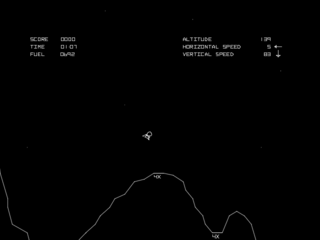
Lunar Lander is a genre of video games loosely based on the 1969 landing of the Apollo Lunar Module on the Moon. In Lunar Lander games, players generally control a spacecraft as it falls toward the surface of the Moon or other astronomical body, using thrusters to slow the ship's descent and control its horizontal motion to reach a safe landing area. Crashing into obstacles, hitting the surface at too high a velocity, or running out of fuel all result in failure. In some games in the genre, the ship's orientation must be adjusted as well as its horizontal and vertical velocities.

In astrodynamics and aerospace, a delta-v budget is an estimate of the total change in velocity (delta-v) required for a space mission. It is calculated as the sum of the delta-v required to perform each propulsive maneuver needed during the mission. As input to the Tsiolkovsky rocket equation, it determines how much propellant is required for a vehicle of given empty mass and propulsion system.

Gravitar is a color vector graphics multidirectional shooter arcade video game released by Atari, Inc. in 1982. Using the same "rotate-and-thrust" controls as Asteroids and Space Duel, the game was known for its high level of difficulty. It was the first of over twenty games Mike Hally designed and produced for Atari. The main programmer was Rich Adam and the cabinet art was designed by Brad Chaboya. Over 5,427 cabinets were produced. An Atari 2600 version by Dan Hitchens was published by Atari in 1983.

Starmaster is a video game written for the Atari 2600 by Alan Miller and published in June 1982 by Activision. The game is similar to Atari 8-bit family game Star Raiders. Starmaster was not ported to other systems, but has been re-released in collections such as Activision Anthology.

Homeworld is a real-time strategy video game developed by Relic Entertainment and published by Sierra Studios on September 28, 1999, for Microsoft Windows. Set in space, the science fiction game follows the Kushan exiles of the planet Kharak after their home planet is destroyed by the Taiidan Empire in retaliation for developing hyperspace jump technology. The survivors journey with their spacecraft-constructing mothership to reclaim their ancient homeworld of Hiigara from the Taiidan, encountering a variety of pirates, mercenaries, traders, and rebels along the way. In each of the game's levels, the player gathers resources, builds a fleet, and uses it to destroy enemy ships and accomplish mission objectives. The player's fleet carries over between levels, and can travel in a fully three-dimensional space within each level rather than being limited to a two-dimensional plane.

Blasteroids is the third official sequel to the 1979 multidirectional shooter video game, Asteroids. It was developed by Atari Games and released in arcades in 1987. Unlike the previous games, Blasteroids uses raster graphics instead of vector graphics, and has power-ups and a boss.
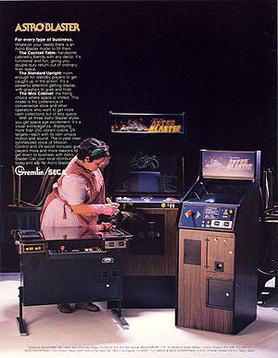
Astro Blaster is a space-themed fixed shooter released in arcades by Sega in 1981. It was designed and programmed by Gary Shannon and Barbara Michalec. The game uses speech synthesis and during attract mode a voice says "Fighter pilots needed in sector wars...play Astro Blaster!" It is the first video game to have a copyright registered in Japan.
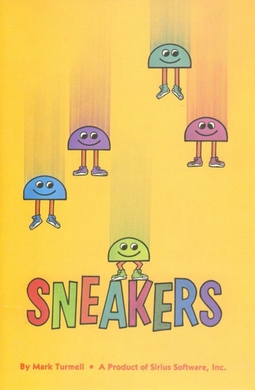
Sneakers is a fixed shooter video game for the Apple II written by Mark Turmell and published by Sirius Software in 1981. An Atari 8-bit family version was released the same year. Sneakers was Turmell's first published game. He later was the lead designer and programmer of 1993's NBA Jam.
Lunar Rescue is an arcade game released by Taito in November 1979. The gameplay has some resemblance to both Taito's own 1978 hit Space Invaders and Atari, Inc.'s Lunar Lander.
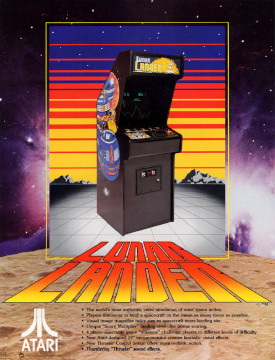
Lunar Lander is a single-player arcade game in the Lunar Lander subgenre. It was developed by Atari, Inc. and released in August 1979. It was the most popular version to date of the "Lunar Lander" concept, surpassing the prior Moonlander (1973) and numerous text-based games, and most later iterations of the concept are based on this Atari version.

Shockwave Assault is a science fiction combat flight simulation video game developed by Advanced Technology Group and published by Electronic Arts for various home video game consoles and PCs. The player takes control of a futuristic fighter plane to defeat extraterrestrial ships and tripods.
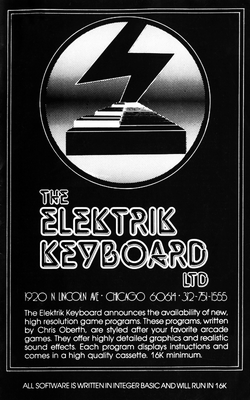
The Elektrik Keyboard was a computer and musical instrument store located on North Lincoln Avenue in Chicago, Illinois in the 1970s and 1980s. In the late '70s it added personal computers to its lineup, and began publishing Apple II computer software written by programmer Chris Oberth. The software, advertised in the company's catalog and sold on cassette, largely consisted of games including some that emulated popular arcade titles.

Depth Charge is a game for the Apple II family of computers, created in 1978 by programmer Chris Oberth and published by The Elektrik Keyboard of Chicago, Illinois.
Christian H. "Chris" Oberth was a video game programmer who began writing games for the Apple II in the late 1970s. He also developed handheld electronic games for Milton Bradley, arcade video games for Stern Electronics and other companies, and ported games to home computers and consoles.
Phasor Zap is a game for the Apple II family of computers, created in 1978 by programmer Chris Oberth and published by The Elektrik Keyboard of Chicago, Illinois.
Pocket Fleet is a space themed MOBA game developed by Turkish studio 'Overdose Caffeine Games'. The Android version was released in September 2012. followed by iOS and Flash versions. An Ouya port was also planned initially but abandoned due to porting difficulties. The game features arena type PvP and PvE game play using Asteroids-like game mechanics.
Space Engineers is a voxel-based sandbox game, developed and published by Czech independent developer Keen Software House. In 2013, the initial developmental release of the game joined the Steam early access program. During the following years of active development, Space Engineers sold over one million units. In total as of 2019 the game has sold over 3.5 million copies In May 2015, for approximately a year and a half, the game's source code was officially available and maintained by KSH to assist the modding community. On December 15, 2016, the game entered Beta and was later officially released on February 28, 2019.

Star Maze is a space-themed shooter taking place in a multidirectional scrolling maze published by Sir-Tech in 1982. It was written by Canadian programmer Gordon Eastman for the Apple II, based on a design by Robert Woodhead. Atari 8-bit family and Commodore 64 versions followed in 1983.

Xenocide is a scrolling shooter for the Apple IIGS written by Pangea Software and published by Micro Revelations in 1989. An IBM PC compatible port using VGA graphics was developed by Manley & Associates and published in 1990. The box cover credits Brian Greenstone as the game's creator on both versions. Xenocide was the first commercially published game from Greenstone's company, Panega Software.
















